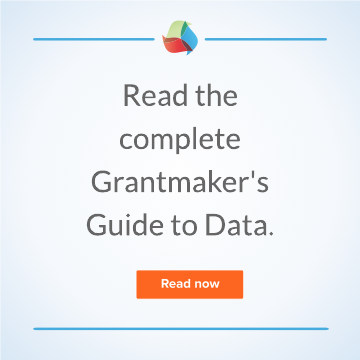
Access to data has given grantmakers the ability to make informed decisions, understand their progress, and find deeper meaning in their funding choices. But data collection, data analysis, and finding this deeper meaning don’t always come easy. Many philanthropy professionals probably didn’t envision data wrangling as part of their job description when they decided to enter the field.
The times, they are a changin’.
Recently, we had a chance to speak at length with Suki O’Kane, the director of administration at the Walter & Elise Haas Fund, and self-proclaimed “data geek,” about how the use of data has changed philanthropy and how it can be used to advance our understanding of solutions to some of today’s most intractable problems.
Fluxx: First off, what’s so good about data? Who needs it?
Suki O’Kane: I look at philanthropy as a public good. Apart from my role at the Fund, as a citizen I feel there's a moral obligation for tax-exempt philanthropy to understand what has been attempted before. For me that means data. I need it to uphold our promise to support social good.
As a practitioner, I see how a slew of information about the grants we make is essential to understanding the impact. When grantmakers share grantmaking successes and failures with their peers, we’re laying the groundwork for movement building. Everyone gets to keep their personality about where they're giving and why, but I feel data – common taxonomies of data – will allow us to be even more thoughtful and coordinated around what we're trying to achieve and be able to talk about it in productive ways.
Fluxx: What are the most important things to keep in mind when grantmakers begin to collect and use data?
O’Kane: An interesting, and unresolved question is how much the funder should collect from applicants, from grantees, or from social data sets, to figure out where to make a difference. After that, how and how much are you – as a funder – going to push back out so that your peers and your grantees can continue that learning cycle with you about what works and what doesn't?
The early problems I’ve seen is that it can be hard to know what you’re tracking and whether it is apples to apples, or monkeys to typewriters, from one grant to the next, or from your grant to the shop down the street's grant. This is a big taxonomy problem and a big value problem about what data means from one program to another inside a foundation, or what data means from one foundation to the next. It’s still true what they say, “When you've met one foundation... you’ve met one foundation.”
I also believe we have an obligation to collect data in a way that is approved both by the grantee and the funder. I respect those who may feel otherwise, but the grantee should be a part of the conversation about what's collected and why. We have to share what we've collected in a way that advances our understanding, and we have to share it with our colleague funders and grantees so we can have a completely inclusive conversation about what we're doing. It just makes sense.
Fluxx: We have the data. Now what?
O’Kane: When I was starting out, data used to be a little tiny drop of water in your cave that you would put your spoon under for weeks in order to take a drink. People still say, "I would use data but it's so hard to get at." Things have changed. Data is coming out of a fire hose. It's hard to get out of its super-soaking way.
Now, discussion in the Grants Manager Network (GMN) and the Technology Affinity Group (TAG) centers around, How can I teach my people how to think about data creatively and open their brains to this?
What we’re finding at the Fund with our newly-minted Fluxx system is that we can now easily take a look at what data we've collected and finally begin to think about what it might mean. We’re poised to meet in a new way, in the Data Visualization Moment where everybody's looking at the data together, seeing what we see, finding out whether what we’ve collected is relevant to our transaction, or if there's something else we need. Starting that conversation is really important, and it can start very simply. My latest: Hey. We collected everybody's operating budget size for 2015. What do we want to do with that?
Fluxx gives me the infrastructure to start asking better questions and spark the creativity of my teams. What do they collect and why? Have they given themselves, and grantees, the right prompts to think through the results of their work?
Fluxx: How can data affect impact?
O’Kane: Once we knock down the barrier of how we talk about data in philanthropy and share it with each other in common ways, we can get to the essential work: how we make meaning out of it. What I found is that you can make it really easy for people to hop in the car and turn the key and start driving, but it's much, much harder to maintain the conversation about where they're going to go, what they’re seeing as they look out the window, what they’re braking for and what they’re accelerating around.
Though I’m a total geek for funder Tech, I never forget this always comes down to human relationships that drive why we give, what we give, and who we’re giving to. I keep asking, "Well, shouldn't data inform your decision making?" The answer is, Yes, but… There'll always be other things that inform my decision making. In certain cases, though, understanding data will truly help us chip away at the intractable problems.
Fluxx: Can or should you use data to course-correct?
O’Kane: I've got super brilliant program officers at the Fund. These people are looking very closely at what they do and responding, cogitating, and designing. I know that they're adapting their strategy based on the realities all around them. The question then becomes, How formal do I have to make this for them to feel like they can really launch a new strategy based on the data they’re seeing?
Program officers might say, "You know, I saw something over here on the left [in the data]. I wonder if I have bandwidth (or permission) to explore it." At that point we’re not talking about problems with data, technology, or Fluxx. We’re confronting how that shop’s stitched itself together in terms of power and hierarchy. There can be structural impediments to using data as a driver. Data needs a culture of learning within the foundation.
To foster a culture of learning in a foundation we must have time to look at everything, including the things that didn't go well. We have to form a habit of mind that addresses those things in a blameless way, with a perspective of great curiosity and potential. This may be too far afield to suggest, but in my shop, my goal is more than creating good technologies and systems for people. It’s also to support them in freeing their minds, taking risks, and engaging in an iterative process about what their grantmaking really reveals.
